steering VOLVO V60 2018 Owner´s Manual
[x] Cancel search | Manufacturer: VOLVO, Model Year: 2018, Model line: V60, Model: VOLVO V60 2018Pages: 406, PDF Size: 9.59 MB
Page 5 of 406
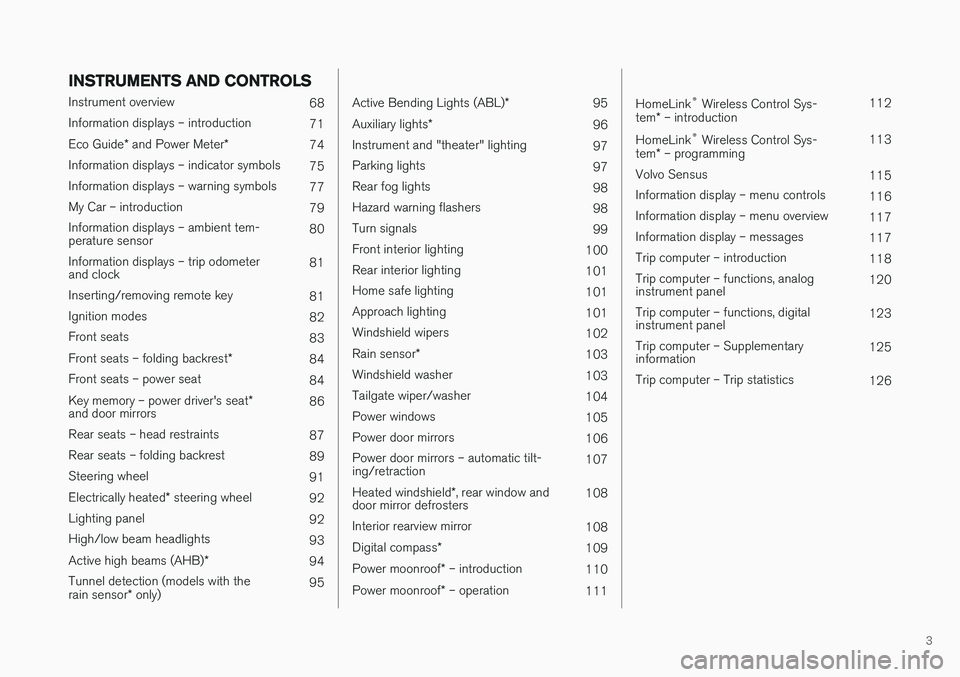
3
INSTRUMENTS AND CONTROLS
Instrument overview 68
Information displays – introduction 71
Eco Guide * and Power Meter *
74
Information displays – indicator symbols 75
Information displays – warning symbols 77
My Car – introduction 79
Information displays – ambient tem- perature sensor 80
Information displays – trip odometerand clock 81
Inserting/removing remote key 81
Ignition modes 82
Front seats 83
Front seats – folding backrest *
84
Front seats – power seat 84
Key memory – power driver's seat *
and door mirrors 86
Rear seats – head restraints 87
Rear seats – folding backrest 89
Steering wheel 91
Electrically heated * steering wheel
92
Lighting panel 92
High/low beam headlights 93
Active high beams (AHB) *
94
Tunnel detection (models with the rain sensor * only) 95
Active Bending Lights (ABL)
*
95
Auxiliary lights *
96
Instrument and "theater" lighting 97
Parking lights 97
Rear fog lights 98
Hazard warning flashers 98
Turn signals 99
Front interior lighting 100
Rear interior lighting 101
Home safe lighting 101
Approach lighting 101
Windshield wipers 102
Rain sensor *
103
Windshield washer 103
Tailgate wiper/washer 104
Power windows 105
Power door mirrors 106
Power door mirrors – automatic tilt- ing/retraction 107
Heated windshield *, rear window and
door mirror defrosters 108
Interior rearview mirror 108
Digital compass *
109
Power moonroof * – introduction
110
Power moonroof * – operation
111
HomeLink®
Wireless Control Sys-
tem * – introduction 112
HomeLink ®
Wireless Control Sys-
tem * – programming 113
Volvo Sensus 115
Information display – menu controls 116
Information display – menu overview 117
Information display – messages 117
Trip computer – introduction 118
Trip computer – functions, analog instrument panel 120
Trip computer – functions, digitalinstrument panel 123
Trip computer – Supplementaryinformation 125
Trip computer – Trip statistics 126
Page 7 of 406
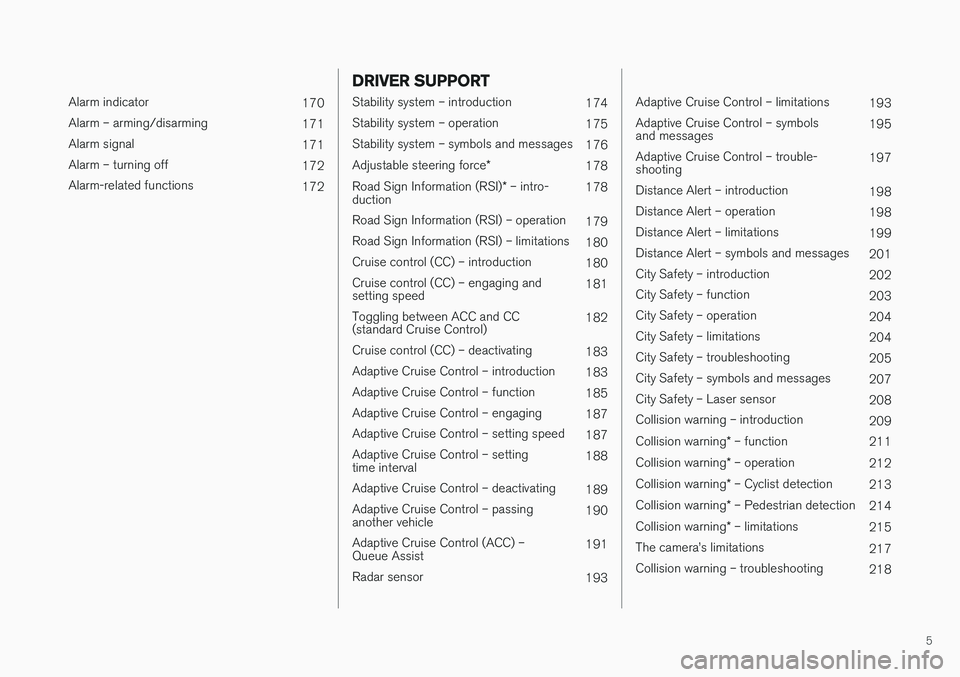
5
Alarm indicator170
Alarm – arming/disarming 171
Alarm signal 171
Alarm – turning off 172
Alarm-related functions 172
DRIVER SUPPORT
Stability system – introduction174
Stability system – operation 175
Stability system – symbols and messages 176
Adjustable steering force *
178
Road Sign Information (RSI) * – intro-
duction 178
Road Sign Information (RSI) – operation 179
Road Sign Information (RSI) – limitations 180
Cruise control (CC) – introduction 180
Cruise control (CC) – engaging and setting speed 181
Toggling between ACC and CC(standard Cruise Control) 182
Cruise control (CC) – deactivating 183
Adaptive Cruise Control – introduction 183
Adaptive Cruise Control – function 185
Adaptive Cruise Control – engaging 187
Adaptive Cruise Control – setting speed 187
Adaptive Cruise Control – settingtime interval 188
Adaptive Cruise Control – deactivating 189
Adaptive Cruise Control – passinganother vehicle 190
Adaptive Cruise Control (ACC) –Queue Assist 191
Radar sensor 193
Adaptive Cruise Control – limitations193
Adaptive Cruise Control – symbols and messages 195
Adaptive Cruise Control – trouble-shooting 197
Distance Alert – introduction 198
Distance Alert – operation 198
Distance Alert – limitations 199
Distance Alert – symbols and messages 201
City Safety – introduction 202
City Safety – function 203
City Safety – operation 204
City Safety – limitations 204
City Safety – troubleshooting 205
City Safety – symbols and messages 207
City Safety – Laser sensor 208
Collision warning – introduction 209
Collision warning * – function
211
Collision warning * – operation
212
Collision warning * – Cyclist detection
213
Collision warning * – Pedestrian detection
214
Collision warning * – limitations
215
The camera
Page 10 of 406
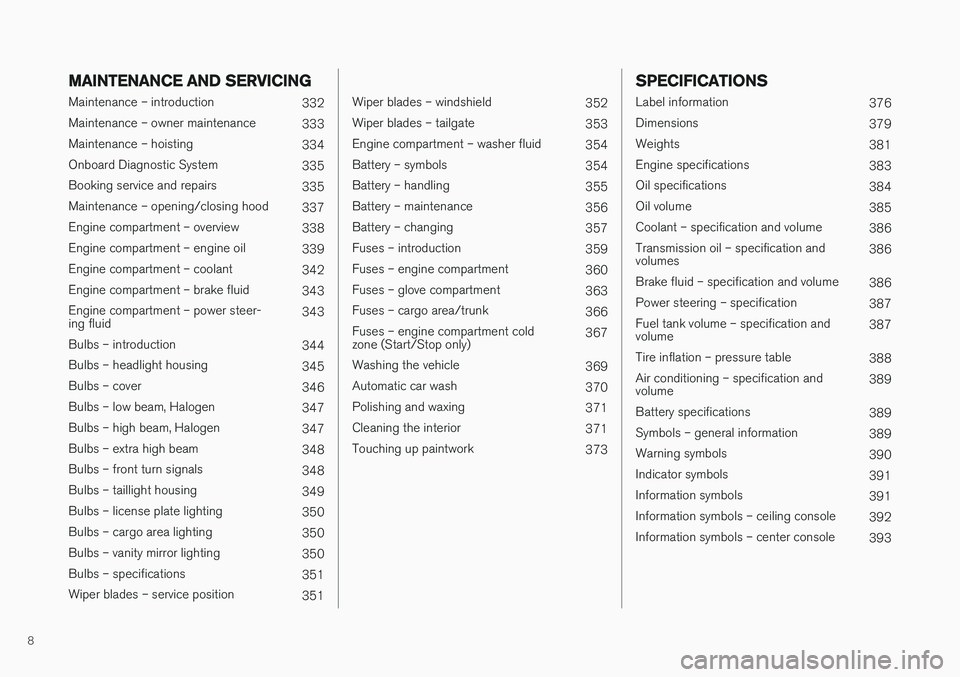
8
MAINTENANCE AND SERVICING
Maintenance – introduction332
Maintenance – owner maintenance 333
Maintenance – hoisting 334
Onboard Diagnostic System 335
Booking service and repairs 335
Maintenance – opening/closing hood 337
Engine compartment – overview 338
Engine compartment – engine oil 339
Engine compartment – coolant 342
Engine compartment – brake fluid 343
Engine compartment – power steer- ing fluid 343
Bulbs – introduction 344
Bulbs – headlight housing 345
Bulbs – cover 346
Bulbs – low beam, Halogen 347
Bulbs – high beam, Halogen 347
Bulbs – extra high beam 348
Bulbs – front turn signals 348
Bulbs – taillight housing 349
Bulbs – license plate lighting 350
Bulbs – cargo area lighting 350
Bulbs – vanity mirror lighting 350
Bulbs – specifications 351
Wiper blades – service position 351
Wiper blades – windshield352
Wiper blades – tailgate 353
Engine compartment – washer fluid 354
Battery – symbols 354
Battery – handling 355
Battery – maintenance 356
Battery – changing 357
Fuses – introduction 359
Fuses – engine compartment 360
Fuses – glove compartment 363
Fuses – cargo area/trunk 366
Fuses – engine compartment cold zone (Start/Stop only) 367
Washing the vehicle 369
Automatic car wash 370
Polishing and waxing 371
Cleaning the interior 371
Touching up paintwork 373
SPECIFICATIONS
Label information376
Dimensions 379
Weights 381
Engine specifications 383
Oil specifications 384
Oil volume 385
Coolant – specification and volume 386
Transmission oil – specification and volumes 386
Brake fluid – specification and volume 386
Power steering – specification 387
Fuel tank volume – specification andvolume 387
Tire inflation – pressure table 388
Air conditioning – specification andvolume 389
Battery specifications 389
Symbols – general information 389
Warning symbols 390
Indicator symbols 391
Information symbols 391
Information symbols – ceiling console 392
Information symbols – center console 393
Page 20 of 406
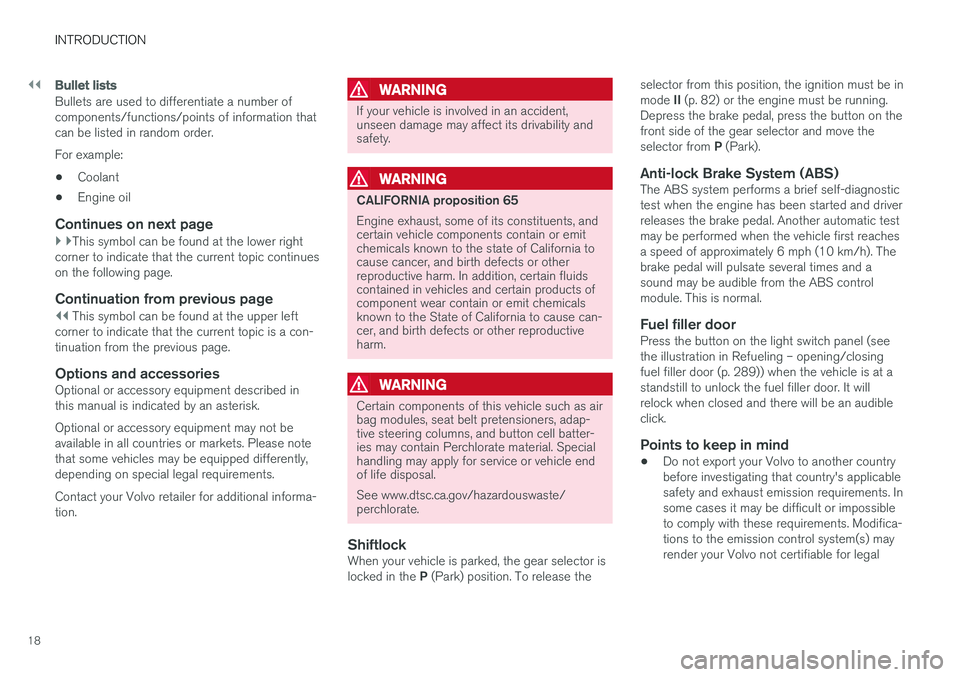
||
INTRODUCTION
18
Bullet lists
Bullets are used to differentiate a number of components/functions/points of information thatcan be listed in random order. For example:• Coolant
• Engine oil
Continues on next page
}
}This symbol can be found at the lower right
corner to indicate that the current topic continues on the following page.
Continuation from previous page
|| This symbol can be found at the upper left
corner to indicate that the current topic is a con- tinuation from the previous page.
Options and accessoriesOptional or accessory equipment described inthis manual is indicated by an asterisk. Optional or accessory equipment may not be available in all countries or markets. Please notethat some vehicles may be equipped differently,depending on special legal requirements. Contact your Volvo retailer for additional informa- tion.
WARNING
If your vehicle is involved in an accident, unseen damage may affect its drivability andsafety.
WARNING
CALIFORNIA proposition 65 Engine exhaust, some of its constituents, and certain vehicle components contain or emitchemicals known to the state of California tocause cancer, and birth defects or otherreproductive harm. In addition, certain fluidscontained in vehicles and certain products ofcomponent wear contain or emit chemicalsknown to the State of California to cause can-cer, and birth defects or other reproductiveharm.
WARNING
Certain components of this vehicle such as air bag modules, seat belt pretensioners, adap-tive steering columns, and button cell batter-ies may contain Perchlorate material. Specialhandling may apply for service or vehicle endof life disposal. See www.dtsc.ca.gov/hazardouswaste/ perchlorate.
ShiftlockWhen your vehicle is parked, the gear selector is locked in the P (Park) position. To release the selector from this position, the ignition must be inmode
II (p. 82) or the engine must be running.
Depress the brake pedal, press the button on the front side of the gear selector and move the selector from P (Park).
Anti-lock Brake System (ABS)The ABS system performs a brief self-diagnostic test when the engine has been started and driverreleases the brake pedal. Another automatic testmay be performed when the vehicle first reachesa speed of approximately 6 mph (10 km/h). Thebrake pedal will pulsate several times and asound may be audible from the ABS controlmodule. This is normal.
Fuel filler doorPress the button on the light switch panel (seethe illustration in Refueling – opening/closingfuel filler door (p. 289)) when the vehicle is at astandstill to unlock the fuel filler door. It willrelock when closed and there will be an audibleclick.
Points to keep in mind
• Do not export your Volvo to another countrybefore investigating that country's applicablesafety and exhaust emission requirements. Insome cases it may be difficult or impossibleto comply with these requirements. Modifica-tions to the emission control system(s) mayrender your Volvo not certifiable for legal
Page 34 of 406
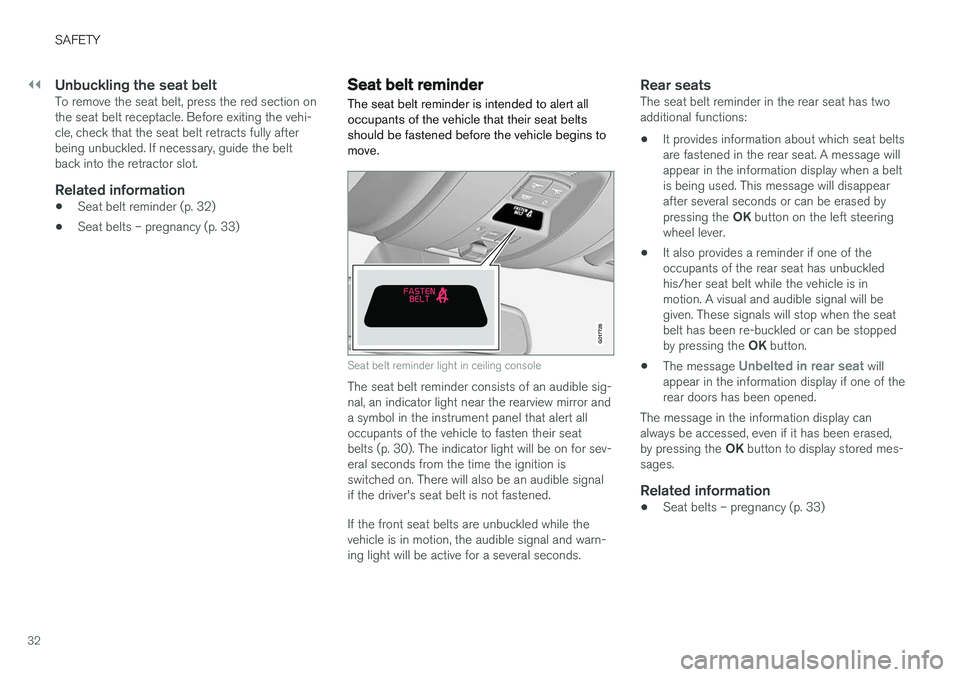
||
SAFETY
32
Unbuckling the seat beltTo remove the seat belt, press the red section on the seat belt receptacle. Before exiting the vehi-cle, check that the seat belt retracts fully afterbeing unbuckled. If necessary, guide the beltback into the retractor slot.
Related information
•Seat belt reminder (p. 32)
• Seat belts – pregnancy (p. 33)
Seat belt reminder The seat belt reminder is intended to alert all occupants of the vehicle that their seat beltsshould be fastened before the vehicle begins tomove.
G017726
Seat belt reminder light in ceiling console
The seat belt reminder consists of an audible sig- nal, an indicator light near the rearview mirror anda symbol in the instrument panel that alert alloccupants of the vehicle to fasten their seatbelts (p. 30). The indicator light will be on for sev-eral seconds from the time the ignition isswitched on. There will also be an audible signalif the driver's seat belt is not fastened. If the front seat belts are unbuckled while the vehicle is in motion, the audible signal and warn-ing light will be active for a several seconds.
Rear seatsThe seat belt reminder in the rear seat has twoadditional functions: • It provides information about which seat belts are fastened in the rear seat. A message willappear in the information display when a beltis being used. This message will disappearafter several seconds or can be erased by pressing the
OK button on the left steering
wheel lever.
• It also provides a reminder if one of the occupants of the rear seat has unbuckledhis/her seat belt while the vehicle is inmotion. A visual and audible signal will begiven. These signals will stop when the seatbelt has been re-buckled or can be stopped by pressing the
OK button.
• The message
Unbelted in rear seat will
appear in the information display if one of the rear doors has been opened.
The message in the information display canalways be accessed, even if it has been erased, by pressing the OK button to display stored mes-
sages.
Related information
• Seat belts – pregnancy (p. 33)
Page 35 of 406
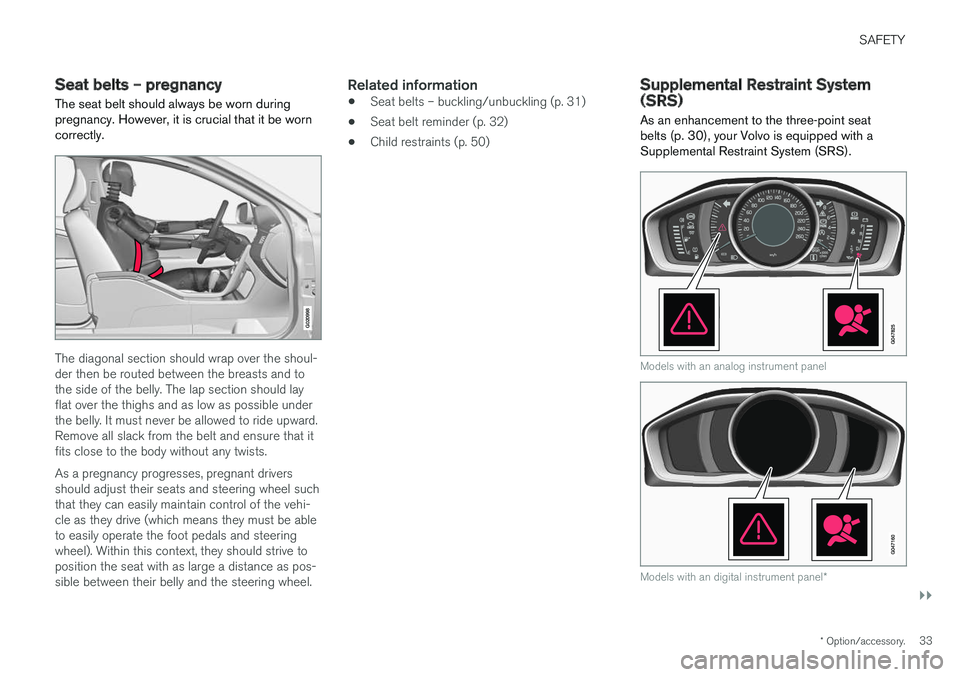
SAFETY
}}
* Option/accessory.33
Seat belts – pregnancy
The seat belt should always be worn during pregnancy. However, it is crucial that it be worncorrectly.
G020998
The diagonal section should wrap over the shoul- der then be routed between the breasts and tothe side of the belly. The lap section should layflat over the thighs and as low as possible underthe belly. It must never be allowed to ride upward.Remove all slack from the belt and ensure that itfits close to the body without any twists. As a pregnancy progresses, pregnant drivers should adjust their seats and steering wheel suchthat they can easily maintain control of the vehi-cle as they drive (which means they must be ableto easily operate the foot pedals and steeringwheel). Within this context, they should strive toposition the seat with as large a distance as pos-sible between their belly and the steering wheel.
Related information
• Seat belts – buckling/unbuckling (p. 31)
• Seat belt reminder (p. 32)
• Child restraints (p. 50)
Supplemental Restraint System (SRS)
As an enhancement to the three-point seat
belts (p. 30), your Volvo is equipped with aSupplemental Restraint System (SRS).
Models with an analog instrument panel
Models with an digital instrument panel *
Page 37 of 406
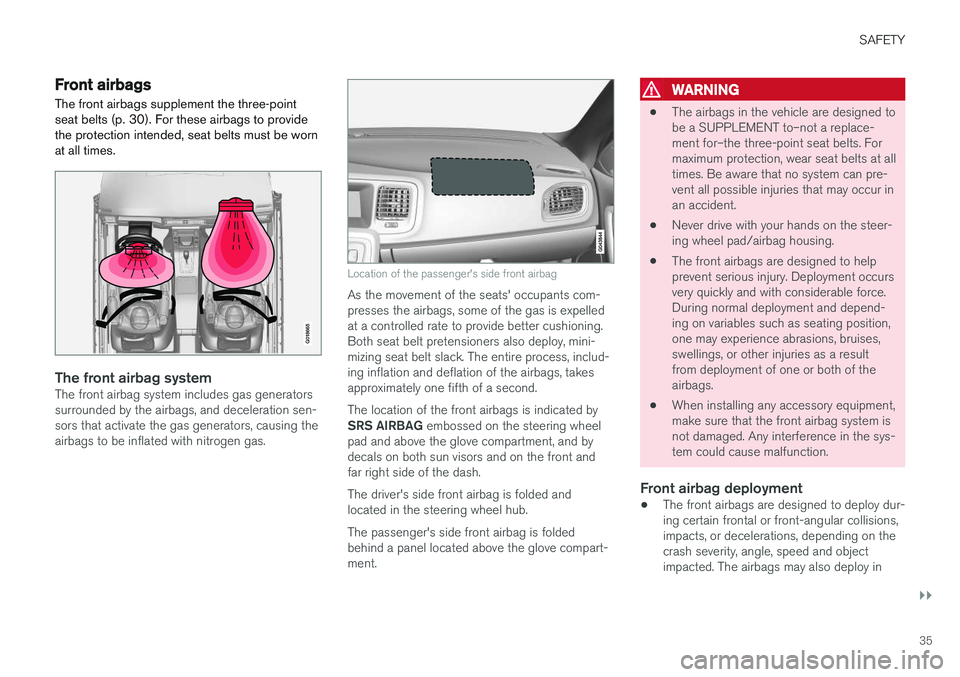
SAFETY
}}
35
Front airbags
The front airbags supplement the three-point seat belts (p. 30). For these airbags to providethe protection intended, seat belts must be wornat all times.
G018665
The front airbag systemThe front airbag system includes gas generators surrounded by the airbags, and deceleration sen-sors that activate the gas generators, causing theairbags to be inflated with nitrogen gas.
Location of the passenger's side front airbag
As the movement of the seats' occupants com- presses the airbags, some of the gas is expelledat a controlled rate to provide better cushioning.Both seat belt pretensioners also deploy, mini-mizing seat belt slack. The entire process, includ-ing inflation and deflation of the airbags, takesapproximately one fifth of a second. The location of the front airbags is indicated by SRS AIRBAG embossed on the steering wheel
pad and above the glove compartment, and by decals on both sun visors and on the front andfar right side of the dash. The driver's side front airbag is folded and located in the steering wheel hub. The passenger's side front airbag is folded behind a panel located above the glove compart-ment.
WARNING
• The airbags in the vehicle are designed to be a SUPPLEMENT to–not a replace-ment for–the three-point seat belts. Formaximum protection, wear seat belts at alltimes. Be aware that no system can pre-vent all possible injuries that may occur inan accident.
• Never drive with your hands on the steer-ing wheel pad/airbag housing.
• The front airbags are designed to helpprevent serious injury. Deployment occursvery quickly and with considerable force.During normal deployment and depend-ing on variables such as seating position,one may experience abrasions, bruises,swellings, or other injuries as a resultfrom deployment of one or both of theairbags.
• When installing any accessory equipment,make sure that the front airbag system isnot damaged. Any interference in the sys-tem could cause malfunction.
Front airbag deployment
•The front airbags are designed to deploy dur-ing certain frontal or front-angular collisions,impacts, or decelerations, depending on thecrash severity, angle, speed and objectimpacted. The airbags may also deploy in
Page 38 of 406
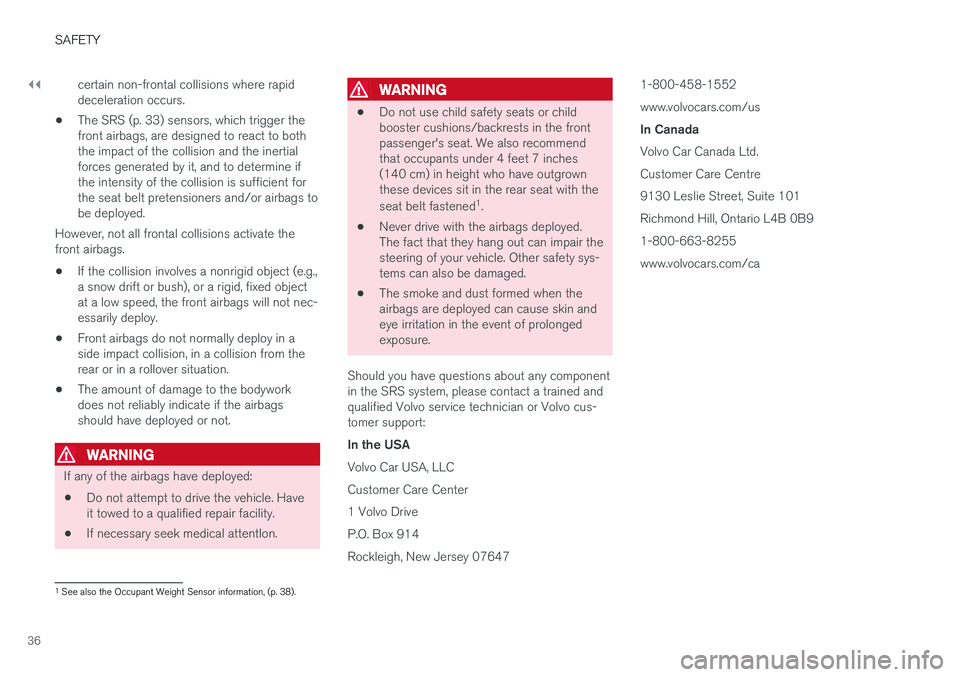
||
SAFETY
36certain non-frontal collisions where rapid deceleration occurs.
• The SRS (p. 33) sensors, which trigger thefront airbags, are designed to react to boththe impact of the collision and the inertialforces generated by it, and to determine ifthe intensity of the collision is sufficient forthe seat belt pretensioners and/or airbags tobe deployed.
However, not all frontal collisions activate thefront airbags.
• If the collision involves a nonrigid object (e.g.,a snow drift or bush), or a rigid, fixed objectat a low speed, the front airbags will not nec-essarily deploy.
• Front airbags do not normally deploy in aside impact collision, in a collision from therear or in a rollover situation.
• The amount of damage to the bodyworkdoes not reliably indicate if the airbagsshould have deployed or not.
WARNING
If any of the airbags have deployed:
• Do not attempt to drive the vehicle. Have it towed to a qualified repair facility.
• If necessary seek medical attentIon.
WARNING
•Do not use child safety seats or child booster cushions/backrests in the frontpassenger's seat. We also recommendthat occupants under 4 feet 7 inches(140 cm) in height who have outgrownthese devices sit in the rear seat with the seat belt fastened 1
.
• Never drive with the airbags deployed. The fact that they hang out can impair thesteering of your vehicle. Other safety sys-tems can also be damaged.
• The smoke and dust formed when theairbags are deployed can cause skin andeye irritation in the event of prolongedexposure.
Should you have questions about any componentin the SRS system, please contact a trained andqualified Volvo service technician or Volvo cus-tomer support: In the USA Volvo Car USA, LLC Customer Care Center1 Volvo DriveP.O. Box 914Rockleigh, New Jersey 07647 1-800-458-1552www.volvocars.com/us In Canada Volvo Car Canada Ltd. Customer Care Centre9130 Leslie Street, Suite 101Richmond Hill, Ontario L4B 0B91-800-663-8255www.volvocars.com/ca
1
See also the Occupant Weight Sensor information, (p. 38).
Page 40 of 406
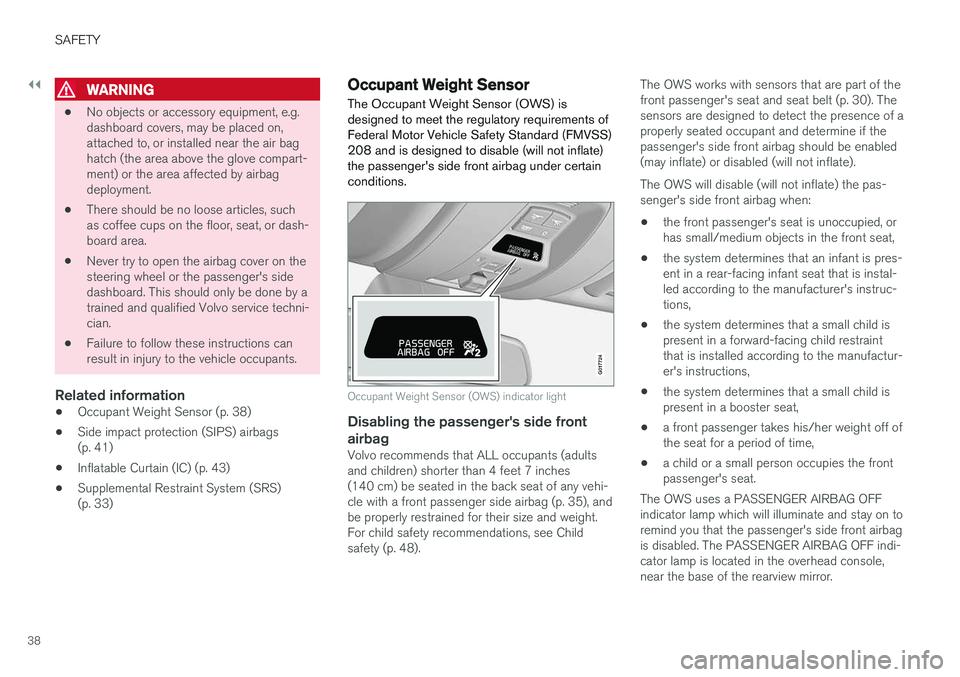
||
SAFETY
38
WARNING
•No objects or accessory equipment, e.g. dashboard covers, may be placed on,attached to, or installed near the air baghatch (the area above the glove compart-ment) or the area affected by airbagdeployment.
• There should be no loose articles, suchas coffee cups on the floor, seat, or dash-board area.
• Never try to open the airbag cover on thesteering wheel or the passenger's sidedashboard. This should only be done by atrained and qualified Volvo service techni-cian.
• Failure to follow these instructions canresult in injury to the vehicle occupants.
Related information
• Occupant Weight Sensor (p. 38)
• Side impact protection (SIPS) airbags(p. 41)
• Inflatable Curtain (IC) (p. 43)
• Supplemental Restraint System (SRS)(p. 33)
Occupant Weight Sensor
The Occupant Weight Sensor (OWS) is designed to meet the regulatory requirements ofFederal Motor Vehicle Safety Standard (FMVSS)208 and is designed to disable (will not inflate)the passenger's side front airbag under certainconditions.
2
2
G017724
Occupant Weight Sensor (OWS) indicator light
Disabling the passenger's side frontairbag
Volvo recommends that ALL occupants (adults and children) shorter than 4 feet 7 inches(140 cm) be seated in the back seat of any vehi-cle with a front passenger side airbag (p. 35), andbe properly restrained for their size and weight.For child safety recommendations, see Childsafety (p. 48). The OWS works with sensors that are part of thefront passenger's seat and seat belt (p. 30). Thesensors are designed to detect the presence of aproperly seated occupant and determine if thepassenger's side front airbag should be enabled(may inflate) or disabled (will not inflate). The OWS will disable (will not inflate) the pas- senger's side front airbag when:
• the front passenger's seat is unoccupied, orhas small/medium objects in the front seat,
• the system determines that an infant is pres-ent in a rear-facing infant seat that is instal-led according to the manufacturer's instruc-tions,
• the system determines that a small child ispresent in a forward-facing child restraintthat is installed according to the manufactur-er's instructions,
• the system determines that a small child ispresent in a booster seat,
• a front passenger takes his/her weight off ofthe seat for a period of time,
• a child or a small person occupies the frontpassenger's seat.
The OWS uses a PASSENGER AIRBAG OFFindicator lamp which will illuminate and stay on toremind you that the passenger's side front airbagis disabled. The PASSENGER AIRBAG OFF indi-cator lamp is located in the overhead console,near the base of the rearview mirror.
Page 72 of 406
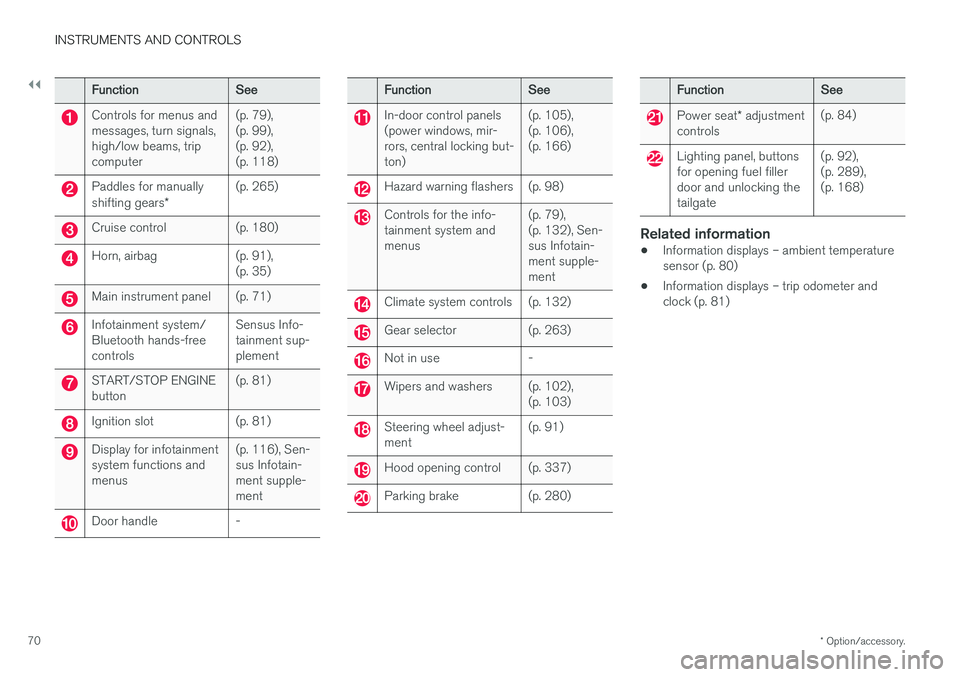
||
INSTRUMENTS AND CONTROLS
* Option/accessory.
70
Function See
Controls for menus and messages, turn signals,high/low beams, tripcomputer(p. 79),(p. 99),(p. 92),(p. 118)
Paddles for manually shifting gears
*(p. 265)
Cruise control (p. 180)
Horn, airbag (p. 91),
(p. 35)
Main instrument panel (p. 71)
Infotainment system/ Bluetooth hands-freecontrolsSensus Info-tainment sup-plement
START/STOP ENGINE button
(p. 81)
Ignition slot (p. 81)
Display for infotainment system functions andmenus(p. 116), Sen-sus Infotain-ment supple-ment
Door handle -
Function
See
In-door control panels (power windows, mir-rors, central locking but-ton)(p. 105),(p. 106),(p. 166)
Hazard warning flashers (p. 98)
Controls for the info- tainment system andmenus
(p. 79),(p. 132), Sen-sus Infotain-ment supple-ment
Climate system controls (p. 132)
Gear selector (p. 263)
Not in use -
Wipers and washers (p. 102),
(p. 103)
Steering wheel adjust- ment(p. 91)
Hood opening control (p. 337)
Parking brake (p. 280)
Function
See
Power seat* adjustment
controls (p. 84)
Lighting panel, buttons for opening fuel fillerdoor and unlocking thetailgate(p. 92),(p. 289),(p. 168)
Related information
•
Information displays – ambient temperature sensor (p. 80)
• Information displays – trip odometer andclock (p. 81)